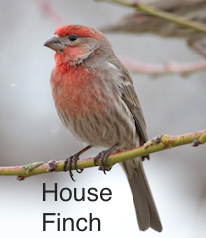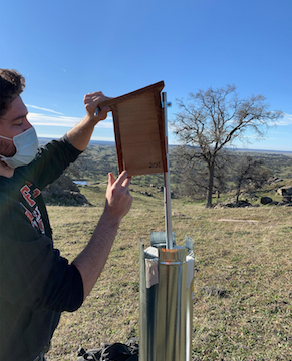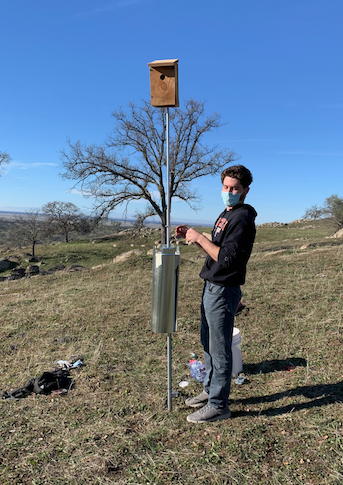Department of Biology
Do birds of a feather flock together?
 Joel Slade, an assistant professor of biology at Fresno State, can tell you that the
adage that birds of a feather stick together is not always true.
Joel Slade, an assistant professor of biology at Fresno State, can tell you that the
adage that birds of a feather stick together is not always true.
That’s because some birds may choose to mate with individuals that are genetically
different from themselves, at least where he thinks it counts the most – their immune
genes.
Dr. Slade's expertise is in avian ecoimmunology and evolutionary ecology. He’s not
running a dating service for birds — as in, fill out this questionnaire, and presto!
you get the mate of your choice. But he is interested in several aspects of avian
ecoimmunology, such as how urbanization may impact the evolution of the avian immune
system, and how birds may relay information about their immunogenetic quality through
sexually selected traits, such as ornate plumage.
Originally from Nova Scotia, Canada, Dr. Slade grew up on the Atlantic coast and became
captivated by marine animals, and studied as an undergraduate to become a marine biologist
and oceanographer.
“Growing up I always had an interest in wildlife, or just nature in general,” he said.
“I grew up with tide pools and I liked being in the water.”
How does a scientist go from studying marine life and oceanography to studying birds?
“During my undergrad studies, I took a course in field ornithology and it completely
changed my trajectory,” he said.
That was it. He was officially addicted to bird biology.
While it’s true that Dr. Slade never started a dating service for birds, at one point
he became quite interested in their avian behavior and sexual selection — looking
at exactly what it is that motivates birds to make their choice of mate. Birds can
be quite elaborate in their appearance and mating rituals, and this does seem to have
an impact on who gets to mate the most. Most songbirds are not loyal to their mate
at the nest as some males produce extra-pair young in the nest of other males in the
population.
“During my master's degree I looked at how plumage coloration can affect mate choice
in European starlings,” he said. “I wanted to know if plumage coloration honestly
signaled quality in both males and females of this species.” Dr. Slade found that
throat feather coloration in European starlings was a good predictor of reproductive
success not in males, but females. He figures that since males sing, that their song,
rather than their plumage coloration, is likely a better predictor of male reproductive
success.
“Many studies have found that sexually selected traits, such as plumage coloration
are great predictors of reproductive success, however, barely anyone investigates
the genes the offspring may inherit from their parents,” he said.
“There has to be a good genetic reason why a bird is going to choose one individual
over another as a mate,” he said. “This is a big question. It depends on the species,
but in some species, the father takes care of the young too. There has to be some
kind of signal to a female that he will be healthy and provide resources, or good
genes, or both, for the offspring.”
These questions led Dr. Slade to investigate an important set of genes during his
Ph.D. that is directly involved in disease resistance - the major histocompatibility
complex (MHC), which is known as the cornerstone of any vertebrate’s adaptive immune
system. These genes encode proteins that present pieces of pathogens to T cells, which
mounts an adaptive immune response, which often results in the production of antibodies
against the invading pathogen.
“The variation within the ability to present these pathogen-derived proteins could
make or break your health,” he said. “You could have high genetic diversity in these
genes, and be able to respond to more pathogens, but if you have low diversity in
these genes, you are limited in your initial immune response. What makes a difference
in some animals is choosing a mate that is compatible with their genotype at these
genes, that is, one that is genetically different from themselves. This way, their
offspring will maximize their diversity at these immune genes and can respond to more
pathogens.”
But how can birds tell who has compatible MHC genotypes?
 “When birds preen, they are taking an oily substance secreted by a gland at the base
of the tail and rubbing it all over their feathers,” he said. “These oils, under heat,
can become a scent. So, in my Ph.D., I looked at the chemical composition of preen
oil, and their MHC genotypes in song sparrows, and I found that there was a relationship.”
This means that this oil is a strong candidate to be a signal avian MHC genotype,
and further research from the same lab where Dr. Slade completed his Ph.D. provided
support for this hypothesis.
“When birds preen, they are taking an oily substance secreted by a gland at the base
of the tail and rubbing it all over their feathers,” he said. “These oils, under heat,
can become a scent. So, in my Ph.D., I looked at the chemical composition of preen
oil, and their MHC genotypes in song sparrows, and I found that there was a relationship.”
This means that this oil is a strong candidate to be a signal avian MHC genotype,
and further research from the same lab where Dr. Slade completed his Ph.D. provided
support for this hypothesis.
(At left) Golden-crowned sparrow in Dr. Joel Slade's hand.
So, do MHC-opposites attract?
“It’s complicated,” he said.
Like Goldilocks and the three bears, it seems, too little or too much [diversity]
is not what songbirds are seeking. It’s something in between that works better for
some animals.
“I found that the male song sparrows that sang the most song types, which is a sexy
trait for this species, actually had intermediate numbers of MHC alleles. Since too
much MHC can be a bad thing, like causing autoimmune disorders, then it may be better
to have intermediate levels of MHC diversity,” he said. “And I found that wild song
sparrows tend to choose mates that weren’t too different at MHC, which I think is
a way to maintain optimal MHC diversity.”
Dr. Slade and his students are studying the factors that affect avian immunity and
sexual selection. Currently, they are trying to establish a population of violet-green
swallows at the San Joaquin Experimental Range, by installing nest boxes.
“I’m trying to recruit students who want to go outdoors but also do research in COVID-safe
conditions,” he said. “I’m trying to get the students involved in research projects
such as monitoring nest boxes. Last week, in my ecology and evolution of birds course,
we went around campus and looked at the incredible diversity of birds that call Fresno
State home. But soon, as it gets warmer, we’re going to go up to the experimental
range to start working on birds that breed in nest boxes.”
 He and his research students work on western bluebirds and violet-green swallows but
are also interested in other species at the experimental range. Since most birds do
not use nest boxes, Dr. Slade must learn to catch them a different way – with mist
nets, a fine-mesh net that birds can’t see.
He and his research students work on western bluebirds and violet-green swallows but
are also interested in other species at the experimental range. Since most birds do
not use nest boxes, Dr. Slade must learn to catch them a different way – with mist
nets, a fine-mesh net that birds can’t see.
“At least once a week, I have been mist-netting, and banding birds with an experienced
colleague,” he said. Dr. Slade and his colleague affix a lightweight aluminum USGS
ID band on a leg for every bird they catch. The data they get from banding birds goes
into a database, which is important in understanding their population trends and conservation.
Since Dr. Slade is interested in bird conservation, he also wonders how humans are
impacting the evolution of the avian immune system.
This curiosity drives a large part of his research program, which is examining how
environmental factors can help shape birds’ resistance to disease.
“My interest is in trying to understand how the immune system can shape their behavior,
and how environments, like urban environments, affect immunity,” he said.
Low gene flow in an urban environment can lead to limited genetic diversity. And this
could be bad for birds who are facing urban stressors and increased disease transfer
in the city.
“I’m interested in seeing overall, how we are shaping their genetic diversity, how
we are shaping the evolution of their immune system, and if they are being exposed
to disease more in urban environments than in rural ones,” he said.
Several urban factors affect birds and their health, including food availability,
pollution, artificial lights, and more. But does city life always spell disaster for
a bird?
 To find out, Dr. Slade is interested in house finches, a bird commonly found at bird
feeders in the Central Valley, and bushtits, a small bird that has been occupying
urban Fresno since the 1990s, to see if there are any (dis)advantages to being in
urban environments.
To find out, Dr. Slade is interested in house finches, a bird commonly found at bird
feeders in the Central Valley, and bushtits, a small bird that has been occupying
urban Fresno since the 1990s, to see if there are any (dis)advantages to being in
urban environments.
A major threat to the birds on campus is the stray cats, which increases the danger
to birds. “I think people should take this seriously and think about ways we can protect
the birds, as cats kill between three to four billion birds a year in the United States,
but we also need to find a way to help the cats too,” Dr. Slade said.
 One of his students is studying house finch coloration, and whether it is an honest
signal of immune gene diversity. Feeders on-campus help Dr. Slade and his students
attract the birds so research can be conducted, but campus cats can decrease the number
of birds that eat at bird feeders. Dr. Slade also reminds us to clean our bird feeders!
Even though they provide supplemental nutrition for birds, they can easily become
a place where birds transfer diseases to each other, such as Salmonella, which is
currently causing deadly salmonellosis in local pine siskins.
One of his students is studying house finch coloration, and whether it is an honest
signal of immune gene diversity. Feeders on-campus help Dr. Slade and his students
attract the birds so research can be conducted, but campus cats can decrease the number
of birds that eat at bird feeders. Dr. Slade also reminds us to clean our bird feeders!
Even though they provide supplemental nutrition for birds, they can easily become
a place where birds transfer diseases to each other, such as Salmonella, which is
currently causing deadly salmonellosis in local pine siskins.
“Keeping birds in close contact with each other just spreads the socially transmitted
pathogens,” he said. “I think one of the most important things to remember is that
it’s very easy for people to take birds for granted … until they’re gone.”
Dr. Slade is excited for future research in his lab and continues to work towards
conserving our amazing local avian fauna.
Joel Slade holds a B.Sc. in Combined Honors Marine Biology and Oceanography from Dalhousie
University, an M.Sc. in Applied Science from Saint Mary's University, and a Ph.D.
in Biology, University of Western Ontario.
See animated gif of Kayla Gussman (M.S. in Biology) releasing a Spotted Towhee.

(At left) Esther Fernandez (M.S. in Biology)
with a white-crowned sparrow.

(At right) Drew Volpp-Garcia (B.S. in Biology) labeling a violet-green swallow nestbox he just installed.
(Below) Drew Volpp-Garcia (B.S. in Biology)
with the very first violet-green swallow nestbox installed.
